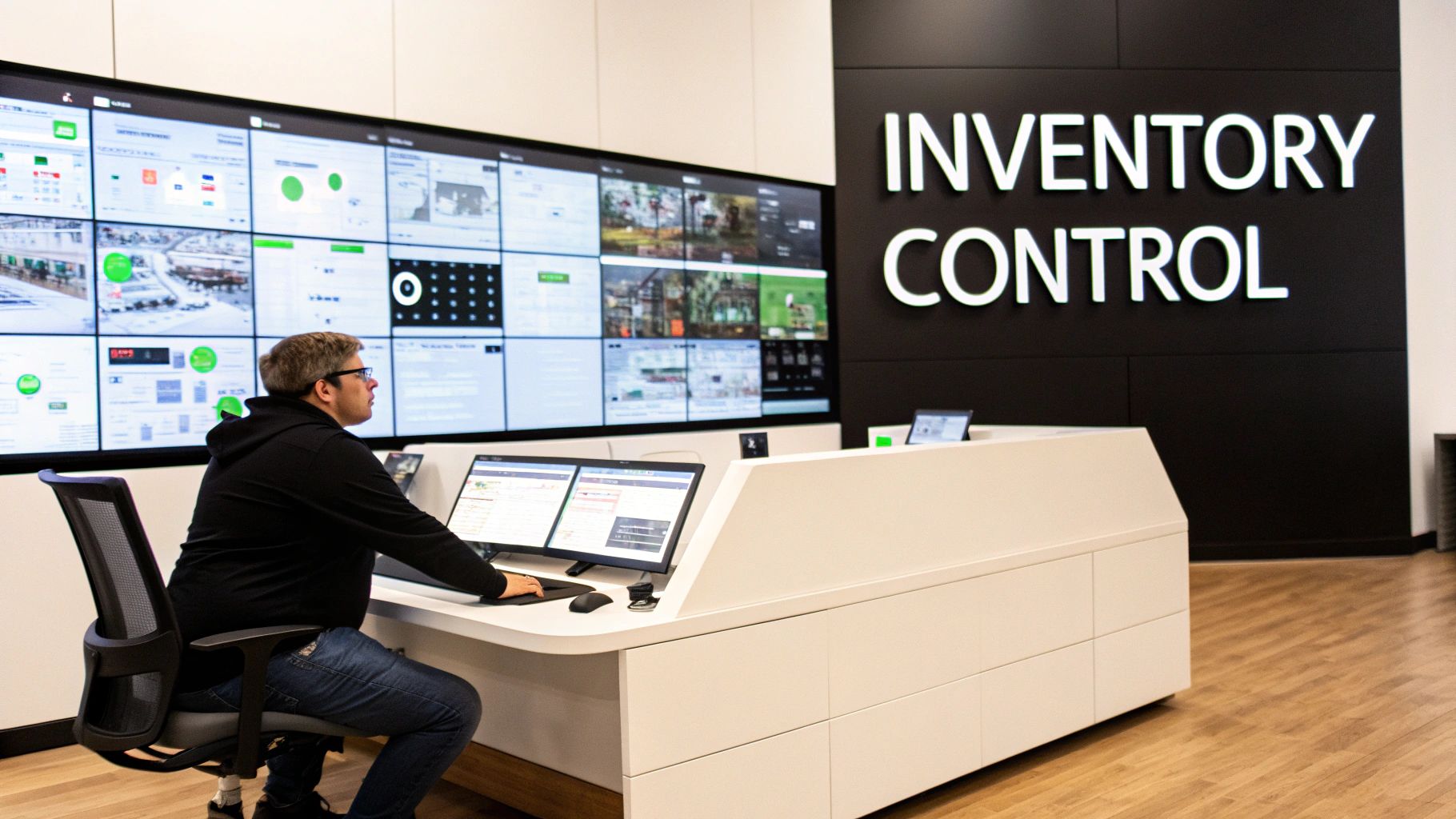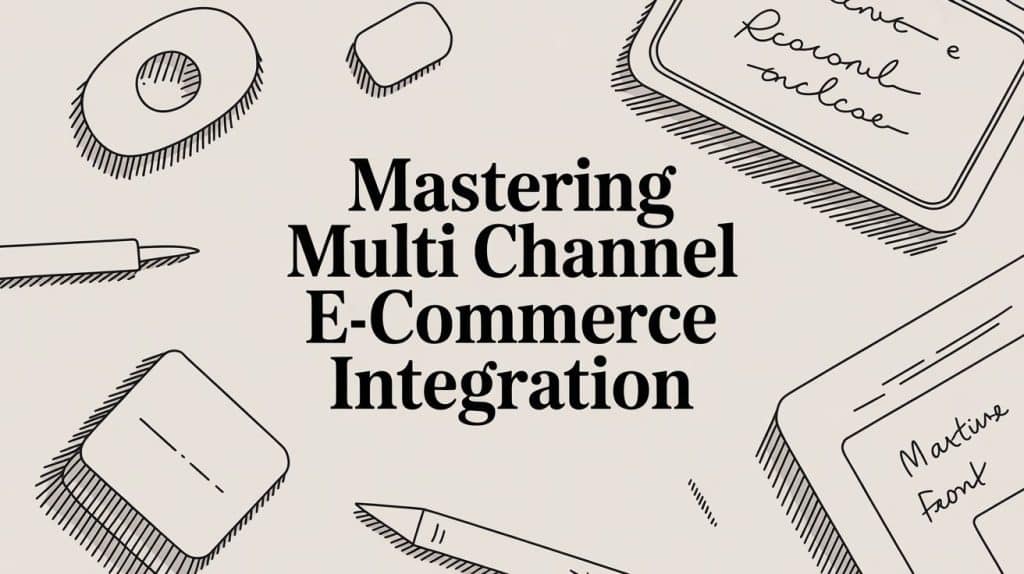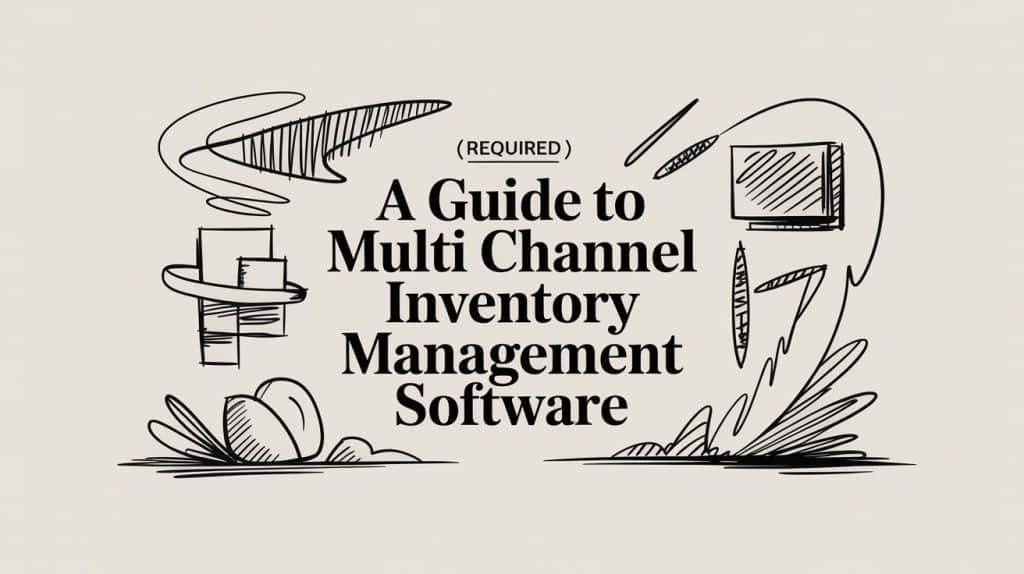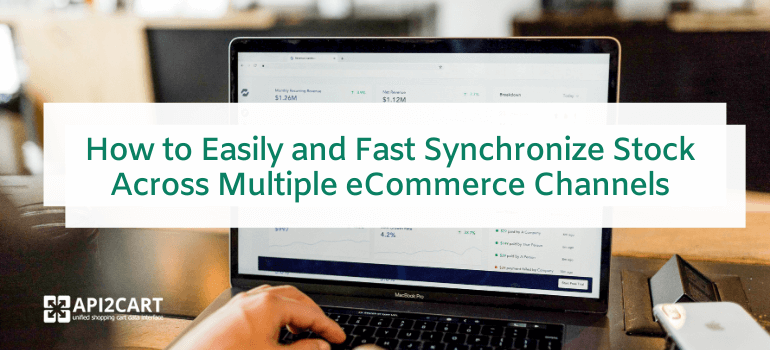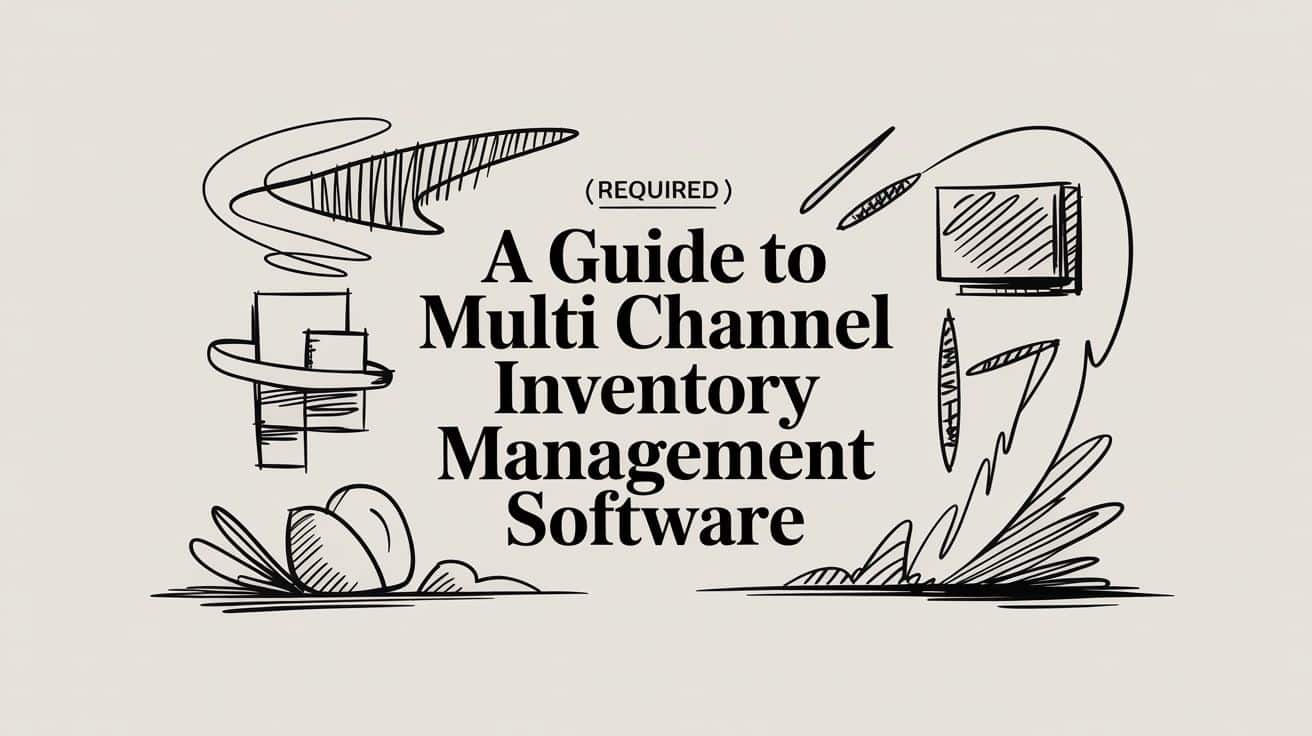
Think of multi channel inventory management software as the central command center for your entire retail operation. It’s the system that tracks inventory across every single sales platform you use. When a product sells on Amazon, its stock count is instantly updated on Shopify, in your brick-and-mortar store, and anywhere else you’re selling. This real-time sync is what stops you from accidentally selling the same item twice.
Taming Your Multi Channel Sales Chaos
Selling products across Amazon, Shopify, physical stores, and social media can feel like directing rush-hour traffic in multiple cities at once. A single sale on one channel kicks off a chain reaction, demanding immediate updates across all the others to avoid overselling. Trying to do this manually is a recipe for disaster—an error-prone nightmare that leads to angry customers and lost sales.
This is where multi channel inventory management software comes in. Think of it as an air traffic controller for your business. Just like a controller has a complete view of every plane in the sky, this software gives you a single, unified picture of every product you own, no matter where it's listed or stored. It’s the key to bringing operational harmony to your sales chaos.
The Central Control Tower for Your Business
This technology becomes your single source of truth, automating the tedious tasks that would otherwise eat up countless hours. It’s not just another tool; it’s the foundation you need to scale your business in today’s complex retail world.
Instead of frantically logging into each platform to adjust stock levels after a sale, the software handles it for you—instantly and automatically. This simple function eliminates costly stockouts and ensures the inventory data your customers see is always accurate and reliable. That operational efficiency translates directly into happier customers and a healthier bottom line.
This software is designed to bring order to chaos. By synchronizing data in real time, it prevents the costly errors that arise from managing multiple sales channels independently, turning a complex process into a streamlined, automated workflow.
The growing demand for these systems tells the whole story. The market was valued at $4.5 billion in 2021 and is on track to hit $11.5 billion by 2026, fueled by the non-stop growth of eCommerce. You can dig deeper into this trend by checking out recent industry reports.
Ultimately, adopting a solid multi channel inventory management system means you can finally:
- Prevent Overselling: Automatically sync inventory changes across all channels to stop selling products you don’t have.
- Improve Accuracy: Get rid of the human error that comes with manual spreadsheet updates.
- Boost Efficiency: Automate repetitive tasks so your team can focus on activities that actually grow the business.
Core Features That Power Your Operations
To really get why multi channel inventory management software is such a game-changer, you have to look under the hood. These aren’t just bullet points on a feature list; they are the gears that work together to automate your operations, slash costly mistakes, and keep your customers happy.
Let's break down the essential functions that turn the chaos of manual tracking into a smooth, reliable system.
Real-Time Inventory Synchronization
This is the absolute heart of the system. Think of real-time inventory synchronization as a single, live scoreboard for your entire business. The second a customer buys a product on Amazon, the score changes, and that new, lower stock level is instantly broadcast to your Shopify store, your Etsy page, and even your brick-and-mortar POS system.
This isn't just a convenience—it prevents the cardinal sin of eCommerce: overselling. Without that instant update, you’re gambling with your reputation, selling items you no longer have. That leads to canceled orders, angry customers, and a brand that looks unreliable. Real-time sync ensures your stock levels are the single source of truth, everywhere, all the time.
SKU Mapping and Product Kitting
Next up is SKU mapping. Let's say you sell the same blue t-shirt on three different platforms. Each marketplace probably gives it a unique product ID. SKU mapping acts like a master translator, creating one central "master" SKU that links all those different listings back to the same physical shirt in your warehouse.
This way, when one blue tee sells on Etsy, the software knows to drop the count for the identical shirt on Amazon and your own website. It’s the only way to keep your numbers straight for the same product sold in different places.
This idea also powers more complex setups like product kitting or bundling. If you sell a "Beginner's Photo Kit" with a camera, lens, and tripod, the software connects those three separate SKUs to the one bundle. When a kit sells, it automatically subtracts one of each component from your inventory. No more selling a bundle when you’re fresh out of tripods.
The power of multi channel inventory management software lies in its ability to create a single, unified view of your products. It translates the unique language of each sales channel into a common inventory dialect that your entire business can understand and act upon instantly.
Automated Purchase Ordering and Reordering
A smart inventory system doesn't just track what's on the shelf; it helps you plan for what's coming. Automated purchase ordering is like having a sharp assistant managing your supply chain. You can set custom reorder points for every product based on how fast it sells and how long it takes to get from your supplier.
For example, you could tell the system to automatically generate a purchase order when your stock of a bestseller drops to a 10-day supply. This proactive approach helps you sidestep stockouts during a sales rush and keeps your most popular items on the virtual shelves. It turns replenishment from a frantic, reactive scramble into a predictable, automated flow. Many top-tier systems also integrate with tools for automated shipping compliance to handle fulfillment just as smoothly.
Centralized Order Management
Finally, these platforms deliver centralized order management. Instead of juggling five different dashboards to see what sold, every order from every channel streams into one unified command center. This gives you a true bird's-eye view of your entire sales operation.
From this single hub, you can:
- Track order statuses: Instantly see which orders are paid, which are packed and ready to go, and which have been delivered.
- Route orders efficiently: If you have multiple warehouses, the system can automatically send an order to the location closest to the customer, cutting down shipping times and costs.
- Generate reports: Dig into sales data by channel, product, or date to spot trends and make smarter decisions about what to stock and where to sell.
Together, these core features form a powerful operational backbone. They give you the clarity and control to run a complex multi-channel business as if it were a single, simple storefront.
Choosing Your Software Architecture
Not all multi-channel inventory management software is created equal. Beneath the slick dashboards and automated reports, there's a technical architecture—the digital blueprint that defines how data moves, how quickly the system responds, and whether it can grow with you.
Picking the right architecture is a lot like choosing the foundation for a house. It has to support what you need today, but it also has to be strong enough for the second story you plan to build down the road. Let's pull back the curtain on the core models you’ll run into.
Hub-and-Spoke vs. Decentralized Models
The most common design you'll see is the hub-and-spoke model. It’s simple and effective. Imagine your inventory software as the center of a wheel. Each of your sales channels—your Shopify store, your Amazon listings, your brick-and-mortar POS—is a "spoke" connected directly to that central hub.
All your data flows into the middle, gets organized and updated, and then gets pushed back out to all the other spokes. This gives you a single source of truth, making everything easier to track and manage. The only catch? If the hub has a problem, every spoke feels it.
The alternative is a decentralized or distributed model, which acts more like a mesh network. Information can flow more freely between different points without always going through a central system. It's less common in off-the-shelf software but can be incredibly resilient, since one part failing doesn't bring down the whole operation. For most eCommerce businesses, though, the control and clarity of the hub-and-spoke model is the way to go.
On-Premises vs. Cloud vs. Hybrid Solutions
Next, you have to decide where your software actually "lives." This choice has a huge impact on your costs, security, and how you access your data day-to-day.
On-Premises: This is the old-school way. You host the software on your own servers, in your own building. You get maximum control over security and data, but it comes with a hefty price tag for hardware, maintenance, and the IT team to run it.
Cloud-Based (SaaS): This is the model most businesses use today. You subscribe to the software, and the vendor hosts and maintains everything for you. It means lower upfront costs, automatic updates, and you can log in from anywhere with an internet connection. It’s flexible, scalable, and just makes sense for modern retail.
Hybrid Model: This approach is the best of both worlds. You might keep highly sensitive financial data on your own local servers but use a cloud platform to handle real-time inventory syncing across all your online channels.
The hybrid approach is gaining a lot of ground as companies look for that perfect balance of security and flexibility. In fact, the market for this model is expected to hit $2.93 billion by 2032. You can dig into the numbers by checking out the latest market analysis.
Comparing Software Architecture and Integration Patterns
Choosing the right architecture and integration method isn't just a technical decision; it's a business one. Your choice will directly impact how quickly you can launch, how much you spend, and how easily your system can adapt as you add new sales channels or tools.
| Approach | Best For | Scalability | Cost | Implementation Speed |
|---|---|---|---|---|
| Hub-and-Spoke | Most eCommerce businesses needing a central source of truth for inventory and orders. | Good, but depends on the central hub's capacity. | Moderate | Fast |
| Decentralized | Large enterprises with complex, custom needs and high-resilience requirements. | Excellent | High | Slow |
| On-Premises | Businesses with strict data security/compliance needs that have in-house IT teams. | Limited by your hardware. | Very High Upfront | Slow |
| Cloud (SaaS) | Businesses of all sizes looking for flexibility, low initial cost, and remote access. | Excellent | Low to Moderate (Subscription) | Very Fast |
| Hybrid | Companies wanting cloud flexibility for operations with on-site control over sensitive data. | Good | High | Moderate |
| Native Connectors | Teams needing to connect to popular platforms (e.g., Shopify, Amazon) quickly and without custom code. | Good, but limited to available connectors. | Low (Often included) | Very Fast |
| Custom API | Businesses with unique workflows or a need to connect with legacy or niche software. | Excellent | High (Development Costs) | Slow |
Ultimately, the best setup provides a clear path to get started quickly (like with SaaS and native connectors) while leaving the door open for more advanced, custom solutions (like API integrations) as your business grows more complex.
Comparing Integration Methods
Once you've picked an architecture, you have to actually connect all your systems. This is where integration patterns come in, and they have a massive effect on how fast you can get things working and how much you'll spend over the long haul.
The most powerful software is useless if it can't communicate with the rest of your tech stack. Your integration strategy is just as important as the software's core features, defining how seamlessly data will flow across your entire business ecosystem.
There are really two main ways to connect your multi channel inventory management software:
Native Connectors: Think of these as pre-built, plug-and-play bridges to popular platforms like Shopify or Amazon. They are incredibly fast to set up, don't require a developer, and are kept up-to-date by the software company. The trade-off? They might not be flexible enough for your specific, unique workflows.
Custom API Development: Using an Application Programming Interface (API) is like hiring an architect to build a custom bridge just for you. You can connect your inventory system to literally any other piece of software, exactly how you want. It offers total flexibility, but it requires serious time, money, and developers to build and maintain.
For most businesses, the smartest move is to find a solution with a deep library of native connectors. This gets you up and running in days, not months. You can always reserve custom API work for those one-off, specialized connections you might need later. This balanced approach turns your technology into an asset, not a bottleneck.
Your Step-By-Step Implementation Plan
Migrating to a new multi channel inventory management software can feel like trying to change a tire on a moving car. It's a high-stakes move where one wrong turn can bring sales to a screeching halt. But with a solid plan, you can turn a chaotic project into a calm, step-by-step process that keeps business running smoothly.
Think of this as your pre-flight checklist. You wouldn't dream of taking off without checking every system, and the same discipline applies here. A clear roadmap takes the guesswork out of the equation and sets you up for a clean launch.
Phase 1: Pre-Launch Preparation
Before you even think about flipping the switch, you need to get your data and your team ready. This is the foundational stage where most implementations go off the rails, usually because everyone is in a rush. According to recent research, a staggering 58% of retailers struggle with inventory accuracy below 80%. Throwing dirty data into a new system will only make that problem worse.
This phase is all about getting your house in order.
Conduct a Full Inventory Audit: Your shiny new software is only as good as the data you feed it. Start with a wall-to-wall physical count of every single item you own. It’s tedious, but it's the only way to establish a trustworthy baseline. Don't skip this.
Cleanse and Standardize Your Data: This is where the real work happens. Comb through your product catalogs and standardize everything—SKU formats, product names, descriptions, you name it. If a t-shirt is "Tee-Blue-L" on Shopify and "TB-L" on Amazon, your new system won’t know they're the same product. Create a single master SKU for every item and map all your channel-specific listings back to it.
Document Existing Workflows: How do you handle returns right now? What about purchase orders or warehouse transfers? Map out every process, no matter how small it seems. This documentation will become your bible when it's time to configure the new software to fit how you actually operate.
A successful software migration is 90% preparation and 10% execution. Skipping the initial data cleanup is like building a house on a shaky foundation—it’s not a matter of if it will cause problems, but when.
Phase 2: Configuration and Testing
With clean data and documented workflows in hand, you can start setting up the software itself. This phase is about teaching the system your rules and running a controlled test to iron out the kinks before you bet the entire business on it. This approach minimizes risk by letting you solve problems on a much smaller scale.
Here’s the game plan:
- Configure Channel-Specific Rules: Set up the logic for each sales channel. For example, you might want to hold back a "safety stock" of 10 units exclusively for your own website while you let marketplaces fight over the rest.
- Integrate Key Systems: Connect your essential tools one at a time. This means your eCommerce platforms, accounting software, and shipping carriers. Test each integration to make sure data is flowing correctly in both directions.
- Run a Pilot Test: Whatever you do, don't go live everywhere at once. Pick one of your smaller, lower-risk channels for a pilot run. Let it operate for a week, processing real orders through the new system. This real-world test will expose issues you could never have predicted on a spreadsheet.
Phase 3: Go-Live and Optimization
Once your pilot test runs smoothly, you’re ready for the main event. This final stage is all about training your team, rolling the software out across all your channels, and setting up a system for ongoing monitoring and improvement.
Train Your Team Thoroughly: Your people need to feel confident with the new tools from day one. Run hands-on training sessions that focus on the actual tasks they perform every day. Give them cheat sheets and easy-to-access documentation for quick reference.
Execute the Full Rollout: It's time to go live across all remaining sales channels. Make sure your implementation team and the software vendor's support crew are on standby to tackle any immediate problems that pop up.
Monitor and Refine: The job isn't done just because you launched. Keep a close eye on your key metrics to see how the system is performing. More importantly, get feedback from your team to find workflow bottlenecks or opportunities for improvement. A great inventory system grows with your business, so think of this as the start of a continuous optimization cycle.
Connecting Your Tech Stack With a Unified API
Trying to manage all the integrations for your multi channel inventory management software can feel like you’re an old-school switchboard operator. Every new sales channel or tool is another wire you have to manually plug in. Before you know it, you're looking at a tangled mess of individual connections that are fragile, expensive, and a nightmare to maintain. That complexity is often the biggest thing holding back a truly efficient tech stack.
But what if you could replace that entire switchboard with a single, universal adapter? That’s the big idea behind a unified eCommerce API. It’s a modern approach that swaps out dozens of separate connections for one powerful integration point.
The Power of a Universal Translator
Think of a unified API as a universal translator for all things eCommerce. Instead of teaching your inventory software how to speak "Shopify," then "Amazon," and then "Magento," you just teach it one master language. The unified API takes care of translating to and from every other platform for you.
This changes everything for your development team. They build one connection to the unified API, and through that single pipeline, you suddenly have access to a huge network of shopping carts and marketplaces. It's a "build once, connect to many" strategy that completely flips the script on integration.
A unified API is an architectural choice that pays dividends over time. It transforms integration from a constant, resource-draining maintenance task into a one-time strategic investment that unlocks immediate scalability and future-proofs your tech stack.
From Complexity to Simplicity
The traditional way of doing things means building, testing, and maintaining a separate connection for each platform. If you sell on five channels and use three other tools (like shipping and accounting software), that’s eight unique integrations your engineers have to support. Forever.
When a platform like WooCommerce updates its API, your team has to scramble to fix that specific connection. A unified API service, like API2Cart, takes on that burden. Their team is responsible for keeping every connection up-to-date, freeing up your developers to focus on your core product instead of constantly putting out integration fires.
This workflow shows a typical three-stage implementation plan, which gets a whole lot simpler when integrations are handled centrally.
As you can see, foundational steps like a full data audit and standardizing your SKUs are critical before you can even think about a pilot test or full rollout.
Key Benefits of the Unified Approach
Going with a unified API isn't just about saving your developers some headaches; it has a direct impact on your business's ability to move quickly and grow.
- Go to Market Faster: Instead of spending months building out individual integrations, you can connect to dozens of platforms almost instantly. This lets you serve more customers on more channels, and you can do it right now.
- Slash Development Costs: The savings here are huge. Building and maintaining just one custom integration can cost tens of thousands of dollars. A unified API can cut these costs by up to 9x because it eliminates all that redundant engineering work.
- Make Maintenance a Breeze: You no longer need to have someone monitoring changelogs for ten different platforms. The unified API provider handles all the updates and version changes behind the scenes, ensuring your data keeps flowing without a hitch.
- Scale Without Fear: Want to add a new marketplace next year? With a unified API, the connection is already there. You can expand into new channels whenever you want without kicking off a massive, time-consuming development project.
A truly robust inventory system has to talk to every part of your operation. For businesses using dropshipping, connecting with partners that offer China fulfillment services for dropshippers is essential for keeping inventory levels accurate. A unified API makes linking to these external partners just as easy as connecting to a sales channel. This creates a fully interconnected network where inventory data flows freely and accurately across your entire business, from the supplier all the way to the customer.
How to Know if Your Investment is Actually Paying Off
Putting a powerful multi channel inventory management software in place is a serious investment in your business's future. But how do you really know if it’s working? To measure your return, you need to look past simple sales numbers and track the Key Performance Indicators (KPIs) that reveal the true health of your operations.
Think of these metrics as your business's vital signs. They tell you exactly where your strategy is hitting the mark and where you need to make adjustments. Tracking the right KPIs turns your software from a simple tracking tool into a powerful engine for continuous improvement and strategic decision-making.
Inventory Turnover Rate
One of the most telling KPIs is the Inventory Turnover Rate. This metric shows how many times your company sells and replaces its entire stock over a specific period, usually a year. A high turnover rate is almost always a good thing—it means products are flying off the shelves and you aren't tying up precious capital in slow-moving goods.
The formula is pretty straightforward:
Inventory Turnover Rate = Cost of Goods Sold (COGS) / Average Inventory
Let's say your annual COGS is $500,000 and your average inventory is valued at $100,000. Your turnover rate is 5. That means you sold through your entire inventory five times during the year. This KPI is your secret weapon for spotting underperforming products and avoiding the cash drain of overstocking.
Stock to Sales Ratio
While turnover measures speed, the Stock-to-Sales Ratio gives you a snapshot of your inventory health right now. It compares the amount of inventory you have on hand to the number of sales you're making, helping you see if your stock levels are actually aligned with customer demand.
- A high ratio might mean you’re overstocked, with too much cash tied up in products that just aren't moving.
- A low ratio could be a red flag for potential stockouts, warning you that you might not have enough inventory to keep up with demand.
This metric is all about finding that sweet spot between having enough stock to keep customers happy and avoiding the carrying costs that come with a bloated warehouse. It’s a delicate balance that has a direct line to your profitability.
It's no surprise that the market for these solutions is booming as more businesses wake up to the power of data-driven inventory decisions. The multichannel inventory management software market is projected to hit roughly $9.8 billion by 2033, all driven by the demand for better forecasting and operational efficiency. You can dive deeper into this trend by reading the full market research.
Order Fulfillment Accuracy
Finally, Order Fulfillment Accuracy is the ultimate measure of how well you're meeting customer expectations. This KPI calculates the percentage of total orders you deliver without a single error—no wrong items, incorrect quantities, or damages. In a market this competitive, getting this right is non-negotiable for building customer loyalty.
The calculation is simple:
(Total Orders - Orders with Errors) / Total Orders x 100
A high accuracy rate, ideally 99% or better, proves your warehouse operations are running like a well-oiled machine. It shows that your inventory data is reliable from the moment an order is placed to the second it lands on a customer's doorstep, directly reflecting the efficiency your software brings to the entire fulfillment process.
Frequently Asked Questions
As you start exploring multi-channel inventory management, you’ll naturally run into some specific questions about how these systems handle day-to-day business realities. Here are some straightforward answers to the questions we hear most often from growing eCommerce brands.
How Does This Software Handle Product Bundles and Kits?
This is a classic inventory puzzle, but modern systems solve it elegantly. They manage bundles by linking multiple component SKUs to a single “parent” SKU. When a bundle sells, the software automatically deducts the correct quantity from each individual component's stock count across every channel.
This is a lifesaver. It stops you from selling a bundle when one of its key parts is actually out of stock. For instance, if you sell a "Holiday Gift Set" made up of a candle, soap, and lotion, the system tracks each item on its own. One sale of that gift set instantly reduces the available stock of all three components, keeping your inventory data perfectly in sync everywhere.
Can This Software Integrate with My Accounting and Shipping Tools?
Absolutely. In fact, strong integration capabilities are a core feature of any worthwhile multi channel inventory management software. The leading solutions come with pre-built connections to popular platforms like QuickBooks, Xero, ShipStation, and all the major shipping carriers.
This creates a seamless workflow where sales data automatically syncs for accounting, and order details are pushed directly to your shippers for fast, accurate fulfillment. This kind of interconnected system gets rid of tedious manual data entry, cuts down on costly errors, and saves you countless hours of administrative work.
What Is the Typical Cost for This Type of Software?
The pricing models can vary, but most platforms operate on a subscription basis (SaaS). Your costs are usually tiered based on a few key factors: your monthly order volume, the number of sales channels you connect, how many user accounts you need, and the total number of SKUs in your catalog.
When you're looking at the price tag, think beyond just the monthly fee. The real value comes from the time you save on manual tasks, the revenue you protect by preventing overselling, and the growth you unlock by making your operations more efficient.
Some vendors might also charge a one-time fee for implementation or setup, so it's always smart to get a clear picture of the full cost structure before you sign on.
Ready to unlock seamless connectivity across 60+ eCommerce platforms? With API2Cart, you integrate once to connect with Shopify, Amazon, WooCommerce, and more, drastically reducing your development time and maintenance costs. Explore how our unified API can scale your B2B software by visiting https://www.api2cart.com to start your free trial.
